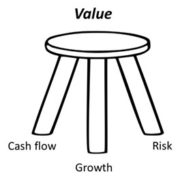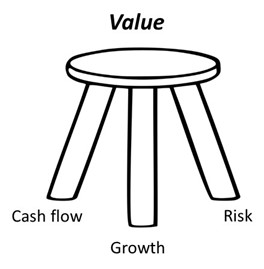When we talk about recapitalization, we’re talking about a partial sale of a company that allows the owner to liquidate some of the value they have in their business. Typically, this involves selling a part of your equity (usually 70-80%) to a third-party, however some business owners do sell just a minority stake.
Recapitalizations are a standard investment tool for private equity firms. They have investor dollars they need to put to work and a timeline in which they’re expected to deliver returns. So they buy businesses with the intent of growing them and/or repackaging them with synergistic businesses for resale approximately 5 to 7 years down the road.
Using this playbook, they generally prefer to buy businesses with an active owner or strong management team in place. You or your existing leadership team will continue to run the business day-to-day while the private equity investor provides resources and assistance to fuel new growth.
Advantages of a Recapitalization
Liquidity: As a business owner, you may have all your financial resources tied up in the business. A partial sale allows you to take some chips off the table, securing your financial future.
Professionalize the business: Recapitalizations can have the effect of increasing management rigor. Your investment partner may help you implement new reporting practices, processes or management software. While these tools help you remain accountable to your new partners, they can also help the business make more informed, data-driven decisions.
And because private equity excels in developing businesses for resale, they understand how to make a business more attractive to buyers and position it for even greater value in a future sale.
A partner for growth: If you see a clear growth opportunity in front of you, but are not prepared to take on new debt or risk at this stage in your life, an investment partner can provide the resources to fuel growth plans.
For example, one business owner in the physical therapy space grew his business from one clinic to 50 over the course of 20 years. After partnering with private equity, the business doubled to 100 locations in just two and a half years.
He got to do what he loved, integrating new clinics, while the investment team focused on acquisitions. When he sells his remaining equity in the business, his minority stake will likely sell for a much larger value than what he received in the initial sale.
Potential disadvantages:
No fast exit: If you are burned out, this is generally not the right approach for you. In a recap model, the investors are typically looking for a business leader who will stay for roughly five years. That doesn’t work if you don’t have any gas left in the tank.
This approach could work, however, if you have a strong management team. Equity can be transitioned to management, creating a new group of minority owners motivated to drive success.
Loss of control: While you will still run the day-to-day business, you will no longer be the primary owner and decision maker. Your investment partner will be involved in all significant financial and strategic decisions.
So before you partner with an investment firm, make sure you feel like your goals align with their intentions. And talk to other business owners they’ve partnered with in the past, to find out how well the relationship worked out.
Pressure to grow: If you’re being recapped late in the life of an investment fund, your investors may need to show returns in just a few years. That could lead to a situation in which you’re pressured to grow quickly.
You could find your investors are more interested in short-term returns than long-term strategic growth. Then again, if your investor is looking to sell quickly, one concentrated push with a faster exit might appeal to you.
At the end of the day, recapitalizations can be a great tool to grow your business and increase your overall value. Finding the right partner takes careful consideration and due diligence. But with the right fit, you can often accomplish more and reap greater rewards than with a traditional full sale.
For further information on recapitalization contact Al Statz at 707-781-8580.
 The more your business revolves around you, the more risk buyers see. To increase business value and marketability, build a strong management team.
The more your business revolves around you, the more risk buyers see. To increase business value and marketability, build a strong management team.



 In explaining value, ESGI default to the simple metaphor of value a three-legged stool with key drivers that determine value; cash flow, growth, and risk. A simple but dynamic formula for determining value is the capitalization of a business’ normalized cash flows divided by the difference between the discount rate and a long-term growth rate;
In explaining value, ESGI default to the simple metaphor of value a three-legged stool with key drivers that determine value; cash flow, growth, and risk. A simple but dynamic formula for determining value is the capitalization of a business’ normalized cash flows divided by the difference between the discount rate and a long-term growth rate;
 When it’s time to sell your business, you will likely have multiple buyer types to choose from. You could receive offers from strategic, financial, and individual buyers.
When it’s time to sell your business, you will likely have multiple buyer types to choose from. You could receive offers from strategic, financial, and individual buyers.

 With a Global pandemic and prospects of a sustained recession with double digit unemployment coupled with West Coast wildfires and East Coast hurricanes, I would say that everyone in these United States is looking forward to ringing in the New Year on January 1st. But before the ball drops on a socially distanced crowd in Time Square, you should think about other changes that may occur as we put 2020 in our rear-view mirrors. Specifically the possibility of tax legislation if the party in power shifts in the Executive and Legislative branches of our government.
With a Global pandemic and prospects of a sustained recession with double digit unemployment coupled with West Coast wildfires and East Coast hurricanes, I would say that everyone in these United States is looking forward to ringing in the New Year on January 1st. But before the ball drops on a socially distanced crowd in Time Square, you should think about other changes that may occur as we put 2020 in our rear-view mirrors. Specifically the possibility of tax legislation if the party in power shifts in the Executive and Legislative branches of our government.




